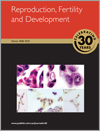Reproduction, Fertility and Development
Volume 30
Number 8 2018
Reproductive research is essential to our understanding of the factors contributing to a healthy pregnancy, birth and child. This review of the 2017 Annual Meeting of the Society for Reproductive Biology summarises the key themes, significant questions and emerging technologies presented in the symposia. In particular, it highlights the importance of the pre- and periconceptional environment for setting a suitable trajectory for offspring health well into adulthood.
Transplantation of ovarian tissue is a good alternative to study follicular development after cryopreservation because in vitro culture is still a major challenge. The present study compared fresh and vitrified goat ovarian tissue after autotransplantation and in vitro culture. Antral follicle formation was observed 3 months after autotransplantation of fresh and vitrified goat ovary and ovarian function was restored.
Early pregnancy loss compromises reproduction in horses; up to 20% of pregnancies diagnosed by Day 15 fail, mostly before Day 40. Daily monitoring of conceptus growth (by ultrasound) and maternal blood progesterone concentrations (by radioimmunoassay) during 16 spontaneous losses between Days 13 and 25 has revealed that luteolysis might contribute to early loss more often than previously contended, with implications for the experimental investigation and clinical management of the problem.
Steroid hormone fluctuations during the mammalian oestrous cycle can be differently affected by dietary ω3 and ω6 polyunsaturated fatty acids (PUFAs). In this study we determined the effects of plasma free PUFA patterns on the guinea pig oestrous cycle and found positive effects of ω3 PUFAs on sex hormone concentrations and negative effects on cortisol concentrations only in oestrus, whereas the effects of ω6 PUFAs were detrimental. The findings demonstrate opposite and selective contributions of PUFAs during different stages of the oestrous cycle and a high biological relevance of plasma free PUFAs.
Equines are bred primarily for sport and pleasure. They are selected mainly on the basis of their pedigree and athletic competence, which are not related to good fertility potential. The fertility of horses is one of the most important factors affecting breeding success. In this study, genetic processes relevant to stallion fertility were identified. To this end, two groups of warmblood stallions were used (a fertile and a subfertile group, determined on the basis of reproductive success and sperm characteristics). The results of this study may be helpful in predicting stallion fertility and in the selection of future breeding stallions.
This work examined the presence and localisation of AQP11 in bull spermatozoa. We observed that AQP11 is localised in the head and tail of bull sperm cells and that it is related to bull sperm cryotolerance. In addition, the relative AQP11-content in fresh bull semen was found to be correlated with reproductive outcomes evaluated both in vitro and in vivo.
Genistein, biochanin A and formononetin are phyto-oestrogens that cause ‘clover disease’, a serious disruption of reproduction in sheep. All three phyto-oestrogens, when present during in vitro maturation of ovine oocytes, will disrupt subsequent fertilisation and embryo development. These observations help explain clover disease, and also show how artificial reproductive technology could be used to screen forage species before industrial release.
Maternal undernutrition may lead to fetal intrauterine growth restriction (IUGR). This study revealed that arginine supplementation to underfed ewes ameliorated fetal IUGR by improving metabolic homeostasis of fetal endocrinology, increasing the availability of amino acids in tissues and affecting the expression of somatotropic axis genes. This indicates that arginine could mitigate significant decreases in fetal growth due to maternal undernutrition.
Polycystic ovary syndrome (PCOS) is one of the most common causes of female infertility. A-Kinase anchor protein 95 was found to be involved in the development of PCOS by regulating aromatase. The findings of this study will help us better understand the pathogenesis of PCOS and may help with the clinical diagnosis and prognosis of PCOS in the future.
Testicular regression after to exposure a short photoperiod in Syrian hamster is a good model in which to study changes in the population of Leydig cells. During regression, the number of Leydig cells decreases and three types of cells (A, B and C) are observed. Type B and C cells exhibit characteristics of necrosis, which implies that elimination of Leydig cells must be the result of necrosis and/or necroptosis.
This study is the first to demonstrate that the transcription factor cAMP response element-binding protein 1 (CREB1) controls ovarian cell proliferation and apoptosis without having to be phosphorylated, but it does not mediate the effects of the upstream hormonal regulators. CREB1 appears to be a novel intracellular regulator of reproduction.
The most important hormone that stimulates the ovary to grow follicles in each sexual cycle is FSH. The effects of FSH on the genome of ovarian cells are wide and complex. Using a DNA microarray, the present study investigated the genes responding to FSH and grouped them by function.




